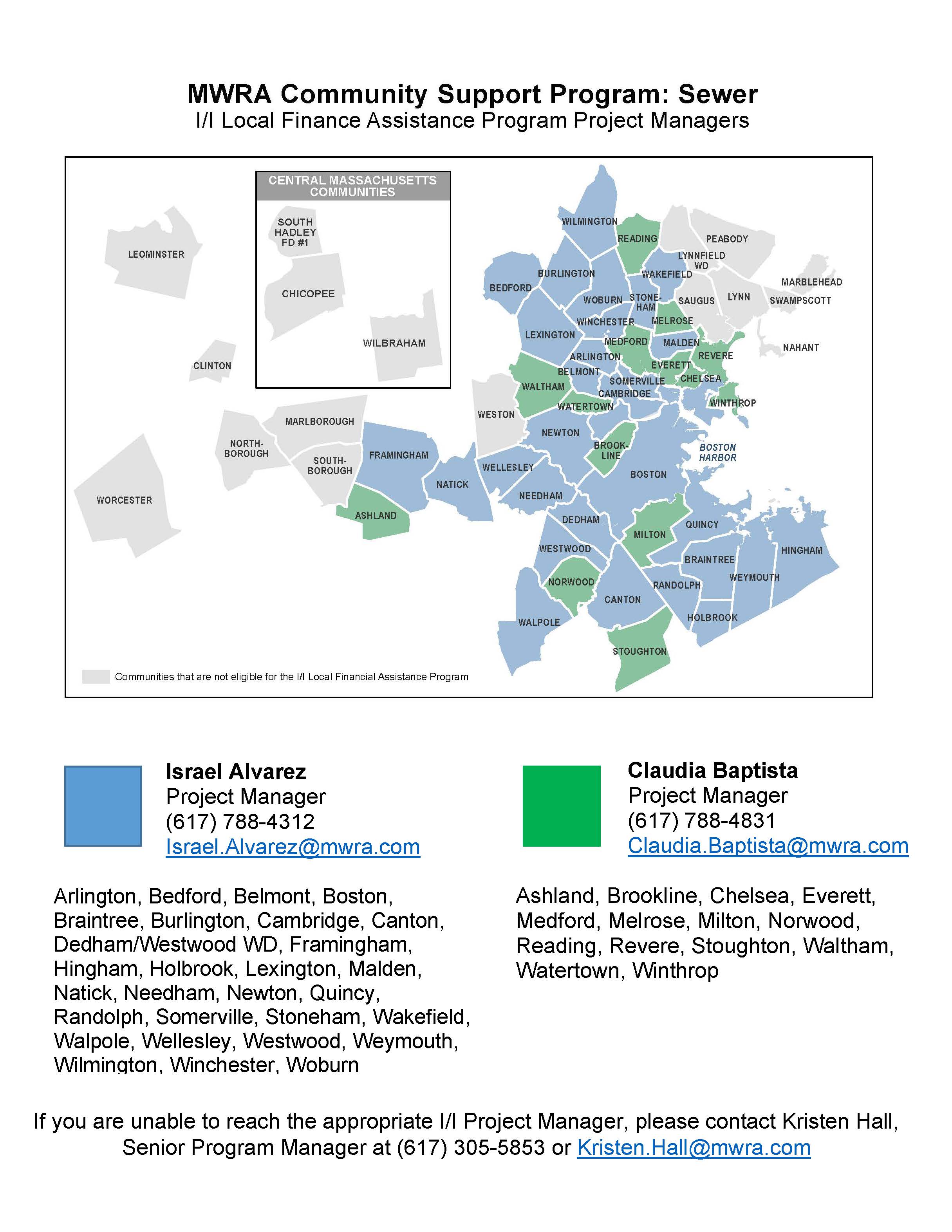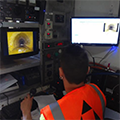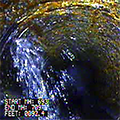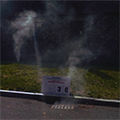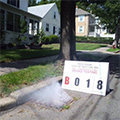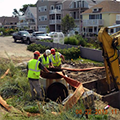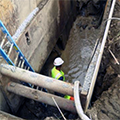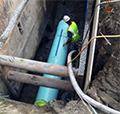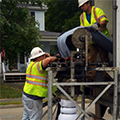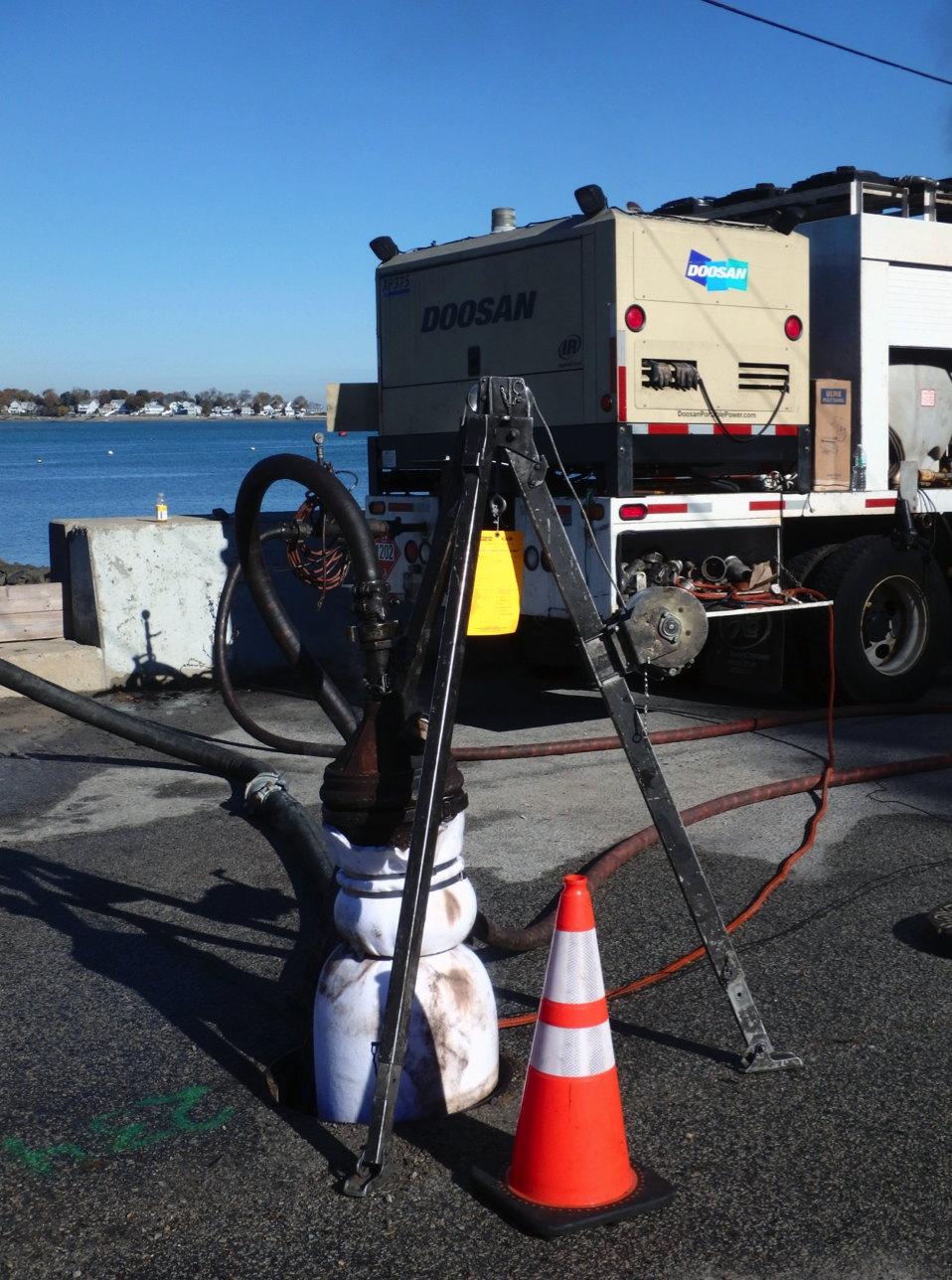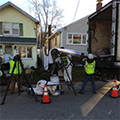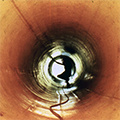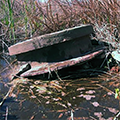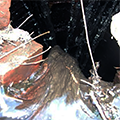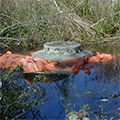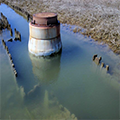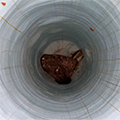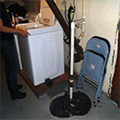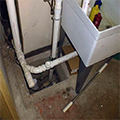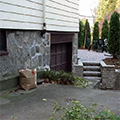| Home |
| About MWRA |
| Water System |
| Sewer System |
| Harbor and Bay |
| School Program |
| Doing Business with MWRA |
| Contact MWRA |
Community
Support Program
Infiltration/Inflow Local Financial Assistance
Massachusetts Water Resources Authority
|
MWRA's I/I Local Financial Assistance Program provides $960 million in grants and interest-free loans to MWRA sewer communities to perform local infiltration and inflow "I/I" reduction and sewer rehabilitation. Funds are approved for distribution through Fiscal Year 2034.
In September 2022, on recommendation of the MWRA Advisory Board, the MWRA Board of Directors approved a $100 million addition to the community Infiltration/Inflow Local Financial Assistance Program. In June 2024, the Board approved an additional $100 million loan only phase to assist communities who have expended all available grant/loan funds.
Program enhancements include:
- Addition of $100 million Phase 15 funds to be distributed as interest-free loans with repayment over 10 years. Phase 15 funds are available as of July 1, 2024.
- Addition of $100 million Phase 14 funds to be distributed as 75% grants and 25% interest-free loans with loan repayment over 10 years. Phase 14 funds will be allocated to each community in the fiscal year that the community’s Phase 12 funds are allocated.
- Communities will be allowed to by-pass the Phase 13 ‘stop-gap’ funding stage (100% interest-free loans) and move directly from Phase 12 grant/loan funding into Phase 14 grant/loan funding;
- Phase 12, 13 and 14 funds will be allocated to a community in the fiscal year following distribution of 50% or more of that community’s Phase 11 funds;
- Phase 10 and 11 funds will become available to a community in the fiscal year following the distribution of 50% or more of that community’s Phase 9 funds;
- Continuation of the 90-day notification to MWRA for community applications exceeding $2 million; and,
- Continuation of the annual spring survey to project a community's three-year MWRA I/I financial assistance spending plan.
Eligible projects are detailed in the Program Guidelines and include:
- Pipeline Replacement
- Public and Private Inflow Source Removal
- I/I Reduction Planning
- Sewer Rehabilitation Construction
- Engineering Design
- Engineering Services During Construction
PROJECT BENEFITS
MWRA's I/I Local Financial Assistance Program was initiated in May 1993 to provide funding to member sewer communities to perform I/I reduction and sewer system rehabilitation projects within their locally-owned collection systems.
This program is a critical component of MWRA’s Regional I/I Reduction Plan. Specifically, local sewer system rehabilitation projects are intended to at least offset ongoing collection system deterioration thus preventing a net increase in regional I/I. In the long-term, system rehabilitation should result in lower I/I, which will allow for future increases in sanitary flows (residential, commercial, industrial, and institutional) without a net increase in total wastewater flow. The program fosters efficient operation and maintenance of local sewer systems.
Regional progress on I/I reduction is detailed in MWRA’s Annual I/I Reduction Report.
Since the program began in 1993, $560.7 million has been distributed to fund 685 local
I/I identification and sewer system rehabilitation projects.
HOW FUNDS ARE ALLOCATED AND DISTRIBUTED
I/I Local Financial Assistance Funds are allocated to member sewer communities based on their percent share of wholesale sewer charges. For grant/loan funds remaining under Program Phases 7/8, member communities receive a 45% grant and a 55% interest-free loan. The loan is repaid to MWRA over a 5-year period beginning one year after distribution of the financial assistance.For grant/loan funds under Program Phases 9 through 12 and Phase 14, member communities will receive a 75% grant and a 25% interest-free loan. The loan will be repaid to MWRA over a 10-year period beginning one year after distribution of the financial assistance. Communities are required to exhaust their remaining earlier phase funds prior to becoming eligible for distribution of later phase funds. Phase 10 and 11 funds become available to a community in the fiscal year following the distribution of half of its Phase 9 funds. Phase 12-14 funds became available to a community in the fiscal year following the distribution of half of its Phase 11 funds. Communities will be allowed to by-pass the Phase 13 ‘stop-gap’ funding stage (100% interest-free loans) and move directly from Phase 12 grant/loan funding into Phase 14 grant/loan funding. A community's allocation of funds is based upon each community’s percent share of the wholesale sewer charges, as detailed in the Funding Summary Table (see link above).
APPLICATIONS OVER $2 MILLION ARE SUBJECT TO A 90-DAY NOTIFICATION
The I/I Local Financial Assistance Guidelines require communities to submit completed financial assistance applications at least 30 days prior to the target funding distribution date. For Phase 9 through 15 funds, community funding applications that exceed $2 million are subject to a 90-day notification period prior to the target distribution date. The completed funding application is still due to MWRA 30-days prior to the target distribution date. However, the extended notification period for large funding applications will assist MWRA in budgeting for the Program and management of its Construction Fund. Based on the combined impact of each quarter’s community funding assistance applications, MWRA’s Executive Director is authorized to waive the 90-day notification rule on a case-by-case basis.
COMMUNITY PROJECTED SPENDING PLAN
Beginning in March 2015, MWRA staff (with assistance from the Advisory Board) has surveyed the communities each spring to develop a 3-year rolling projected spending plan for Phase 9 through 14 funds. Community projections for the first year should be as close to actual as possible, with the second and third year being planning estimates. The goal will be to provide the best available information to the MWRA Budget Department in early May to assist in finalizing MWRA’s annual CIP.
BACKGROUND ON INFILTRATION AND INFLOW
Wastewater discharged by member sewer communities to MWRA is influenced by seasonal and wet-weather conditions related to infiltration and inflow (I/I). I/I is extraneous water that enters all wastewater collection systems through a variety of sources. I/I, as well as stormwater from combined sewers, reduce sewer system capacity that would otherwise be available to transport sanitary flow.
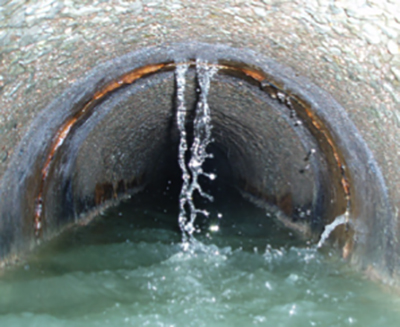
Infiltration is groundwater that enters the collection system through physical defects such as cracked pipes/manholes or deteriorated joints. Typically, many sewer pipes (as well as private service laterals connecting homes and businesses) are below the surrounding groundwater table. Therefore, leakage into the sewer (infiltration) is a broad problem that is difficult and expensive to identify and reduce.
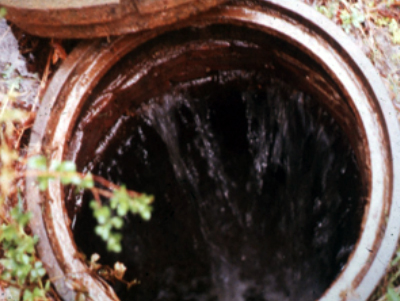
Inflow is extraneous flow entering the collection system through point sources and may be directly related to storm water run-off from sources such as roof leaders, yard and area drains, basement sump pumps, manhole covers, cross connections from storm drains or catch basins, drains from springs and swampy areas, leaking tide gates, etc.
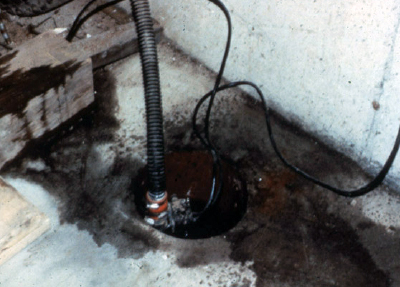
TYPICAL SEWER SYSTEM REHABILITATION PROJECTS
Internal television inspection of sewers is performed to identify sewer defects and I/I. The photos below show a technician remotely operating a TV inspection camera inside a sewer pipe. In the second photo, groundwater infiltration into the sewer pipe is viewed through the video from the TV inspection camera.
__
PDF files on this page require Adobe Acrobat Reader ® (free download).
Updated
July 19, 2024
